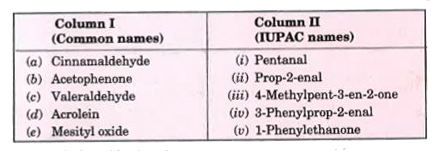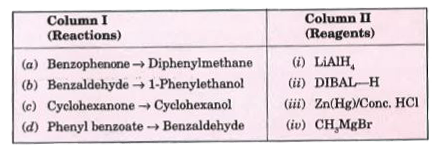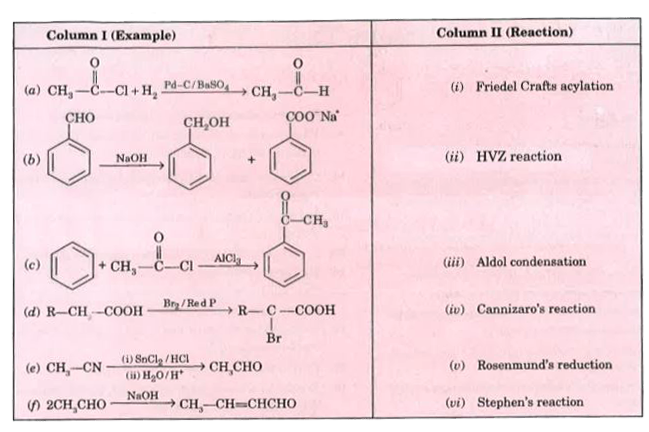Complete Solutions to NCERT FILE (NCERT EXEMPLAR PROBLEMS ) (MATCHING TYPE QUESTIONS) of chapter ALDEHYDES ,KETONES AND CARBOXYLIC ACIDS of Class 12 book with complete answers and questions
| Class 12 | CHEMISTRY |
| Chapter | ALDEHYDES ,KETONES AND CARBOXYLIC ACIDS |
| MODERN PUBLICATION | NCERT FILE (NCERT EXEMPLAR PROBLEMS ) (MATCHING TYPE QUESTIONS) |
| Number Of Questions | 9 |
| Academic Year | 2023-24 |
Match the column names gives in Column I with the IUPAC names given is coloumn II.

View SolutionMatch the common names gives in Column I with the IUPAC names given is coloumn II.

View SolutionMatch the column names gives in Column I with the IUPAC names given is coloumn II.

View SolutionMatch the common names gives in Column I with the IUPAC names given is coloumn II.

View SolutionAssertion (A): Formaldehyde is a planar molecule.
Reason (R) :It contains `sp^(2)` hybridised carbon atom.
View SolutionAssertion (A) compound containing -CHO group are easily oxidised to corresponding carboxylic acids
Reason (R) : Carboxylic acids can be reduced to alcohols by treatment with `LiAlH_(4)`
View SolutionAssertion (A) The `alpha`-hydrogen atom in carbonyl compounds is less acidic.
Reason (R) The anion formed after the loss of `alpha`-hydrogen atom is resonance stabilised.
View SolutionAssertion : Aromatic aldehydes and formaldehyde undergo Cannizzaro reaction
Reason : Aromatic aldehydes are almost as reactive as formaldehyde.
View SolutionAssertion (A) Aldehydes and ketones, both react with Tollen's reagent to form silver mirror.
Reason (R) Both, aldehydes and ketones contain a carbonyl group.
View Solution
NCERT FILE (NCERT EXEMPLAR PROBLEMS ) (MATCHING TYPE QUESTIONS) questions and complete solutions for chapter ALDEHYDES ,KETONES AND CARBOXYLIC ACIDS of MODERN PUBLISHERS CHEMISTRY (HINGLISH) of Class 12
All Exercises from MODERN PUBLICATION Class 12 CHEMISTRY ALDEHYDES ,KETONES AND CARBOXYLIC ACIDS
- COMPETITION FILE ( OBJECTIVE TYPE QUESTIONS - MULTIPLE CHOICE QUESTIONS (MCQ) ( A. MULTIPLE CHOICE QUESTIONS )
- COMPETITION FILE ( OBJECTIVE TYPE QUESTIONS - MULTIPLE CHOICE QUESTIONS (MCQ) ( B. MULTIPLE CHOICE QUESTIONS )
- COMPETITION FILE ( OBJECTIVE TYPE QUESTIONS - MULTIPLE CHOICE QUESTIONS (MCQ) ( C. MULTIPLE CHOICE QUESTIONS )
- COMPETITION FILE ( OBJECTIVE TYPE QUESTIONS - MULTIPLE CHOICE QUESTIONS (MCQ) ( D. MULTIPLE CHOICE QUESTIONS )
- COMPETITION FILE ( OBJECTIVE TYPE QUESTIONS - MULTIPLE CHOICE QUESTIONS (MCQ) ( INTEGER TYPE QUESTIONS )
- Conceptula Questions 1
- Conceptula Questions 2
- EXAMPLE
- HOTS HIGHER ORDER THINKING SKILLS
- NCERT FILE (NCERT EXEMPLAR PROBLEMS ) (MATCHING TYPE QUESTIONS)
- NCERT FILE (NCERT EXEMPLAR PROBLEMS ) (MULTIPLE CHOICE QUESTIONS ( TYPE -I)
- NCERT FILE (NCERT EXEMPLAR PROBLEMS ) (MULTIPLE CHOICE QUESTIONS ( TYPE -II)
- NCERT FILE (NCERT EXEMPLAR PROBLEMS ) (SHORT ANSWER TYPE QUESTIONS )
- NCERT FILE (NCERT IN TEXT QUESTIONS )
- NCERT FILE (NCERT TEXTBOOK EXERCISES )
- PRACTICE PROBLEMS
- QUICK MEMORY TEST ( A. SAY TRUE OR FALSE )
- QUICK MEMORY TEST ( B. COMPLETE THE MISSING LINKS )
- QUICK MEMORY TEST ( C. CHOOSE THE CORRECT ALTERNATIVE )
- REVISION EXERCISES (OBJECTIVE QUESTIONS - ASSERTION REASON QUESTIONS )
- REVISION EXERCISES (OBJECTIVE QUESTIONS - LONG ANSWER QUESTIONS )
- REVISION EXERCISES (OBJECTIVE QUESTIONS - MULTIPLE CHOICE QUESTIONS )
- REVISION EXERCISES (OBJECTIVE QUESTIONS - PASSAGE BASED QUESTIONS )
- REVISION EXERCISES (OBJECTIVE QUESTIONS - SHORT ANSWER QUESTIONS )
- REVISION EXERCISES (OBJECTIVE QUESTIONS - VERY SHORT ANSWER QUESTIONS )
- UNIT PRACTICE TEST